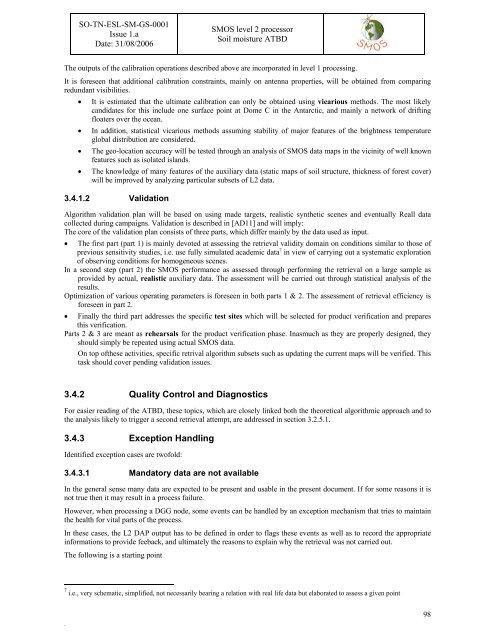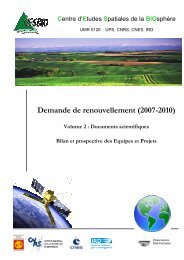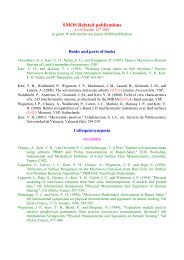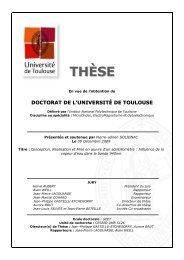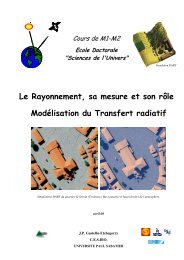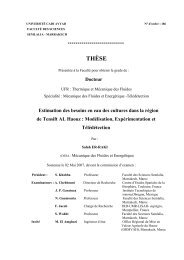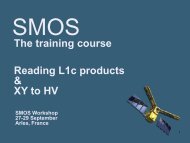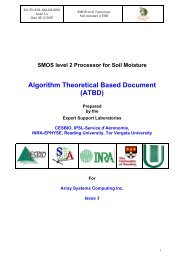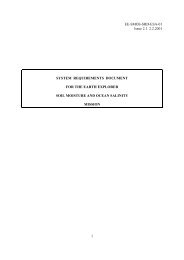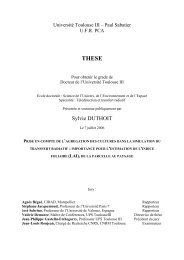Algorithm Theoretical Based Document (ATBD) - CESBIO
Algorithm Theoretical Based Document (ATBD) - CESBIO
Algorithm Theoretical Based Document (ATBD) - CESBIO
Create successful ePaper yourself
Turn your PDF publications into a flip-book with our unique Google optimized e-Paper software.
SO-TN-ESL-SM-GS-0001<br />
Issue 1.a<br />
Date: 31/08/2006<br />
SMOS level 2 processor<br />
Soil moisture <strong>ATBD</strong><br />
The outputs of the calibration operations described above are incorporated in level 1 processing.<br />
It is foreseen that additional calibration constraints, mainly on antenna properties, will be obtained from comparing<br />
redundant visibilities.<br />
• It is estimated that the ultimate calibration can only be obtained using vicarious methods. The most likely<br />
candidates for this include one surface point at Dome C in the Antarctic, and mainly a network of drifting<br />
floaters over the ocean.<br />
• In addition, statistical vicarious methods assuming stability of major features of the brightness temperature<br />
global distribution are considered.<br />
• The geo-location accuracy will be tested through an analysis of SMOS data maps in the vicinity of well known<br />
features such as isolated islands.<br />
• The knowledge of many features of the auxiliary data (static maps of soil structure, thickness of forest cover)<br />
will be improved by analyzing particular subsets of L2 data.<br />
3.4.1.2 Validation<br />
<strong>Algorithm</strong> validation plan will be based on using made targets, realistic synthetic scenes and eventually Reall data<br />
collected during campaigns. Validation is described in [AD11] and will imply:<br />
The core of the validation plan consists of three parts, which differ mainly by the data used as input.<br />
• The first part (part 1) is mainly devoted at assessing the retrieval validity domain on conditions similar to those of<br />
previous sensitivity studies, i.e. use fully simulated academic data 7 in view of carrying out a systematic exploration<br />
of observing conditions for homogeneous scenes.<br />
In a second step (part 2) the SMOS performance as assessed through performing the retrieval on a large sample as<br />
provided by actual, realistic auxiliary data. The assessment will be carried out through statistical analysis of the<br />
results.<br />
Optimization of various operating parameters is foreseen in both parts 1 & 2. The assessment of retrieval efficiency is<br />
foreseen in part 2.<br />
• Finally the third part addresses the specific test sites which will be selected for product verification and prepares<br />
this verification.<br />
Parts 2 & 3 are meant as rehearsals for the product verification phase. Inasmuch as they are properly designed, they<br />
should simply be repeated using actual SMOS data.<br />
On top ofthese activities, specific retrival algorithm subsets such as updating the current maps will be verified. This<br />
task should cover pending validation issues.<br />
3.4.2 Quality Control and Diagnostics<br />
For easier reading of the <strong>ATBD</strong>, these topics, which are closely linked both the theoretical algorithmic approach and to<br />
the analysis likely to trigger a second retrieval attempt, are addressed in section 3.2.5.1.<br />
3.4.3 Exception Handling<br />
Identified exception cases are twofold:<br />
3.4.3.1 Mandatory data are not available<br />
In the general sense many data are expected to be present and usable in the present document. If for some reasons it is<br />
not true then it may result in a process failure.<br />
However, when processing a DGG node, some events can be handled by an exception mechanism that tries to maintain<br />
the health for vital parts of the process.<br />
In these cases, the L2 DAP output has to be defined in order to flags these events as well as to record the appropriate<br />
informations to provide feeback, and ultimately the reasons to explain why the retrieval was not carried out.<br />
The following is a starting point<br />
7 i.e., very schematic, simplified, not necessarily bearing a relation with real life data but elaborated to assess a given point<br />
.<br />
98


